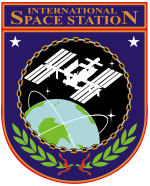International Space Station
Kailangang isapanahon ang artikulong ito. |
Ang International Space Station (ISS) ay isang space station o isang tinitirhang artipisyal na satellite sa mababang orbito ng mundo. Ito ang ikasiyam na space station na tinitirhan ng mga tripulante at sumusunod sa mga space station na Salyut, Almaz at Mir ng Sobyet o Ruso at Skylab ng Amerika. Ang IIS ay isang modular na istrukturang ang unang bahagi ay inilunsad noong 1998.[5] Ito ngayon ang pinakamalaking katawang artipisyal sa orbito at kadalasang makikita sa angkop na panahon ng hubad na mata mula sa mundo.[6] Ang ISS ay binubuo ng napresyong mga module, mga panlabas na truss, mga solar array at iba pa. Ang mga bahagi ng ISS ay inilusad ng mga Amerikanong Space Shuttle gayundin ng mga Rusong rocket na Proton at Soyuz rockets.[7] Ang mga limitasyon sa budget ay humantong sa pagsasama ng tatlong mga proyektong space station sa Hapones na module na Kibō at Canadian robotics. Noong 1993 ang ilang bahaging itinayong mga bahagi para sa Sobyet/Rusong space station na Mir-2, ang iminungkahing Amerikanong Freedom at iminungkahing Europeong Columbus ay nagsama sa isang multinasyonal na programme.[7]
 | ||
| Oblique forward view in November 2021 | ||
 | ||
| ISS insignia | ||
| Station statistics | ||
|---|---|---|
| COSPAR ID | 1998-067A | |
| Call sign | Alpha | |
| Crew | Fully crewed 6 Currently aboard 6 (Expedition 37) | |
| Launch | 1998–2020 | |
| Launch pad | Baikonur 1/5 and 81/23 Kennedy LC-39 | |
| Mass | approximately 450,000 kg (990,000 lb) | |
| Length | 72.8 m (239 tal) | |
| Width | 108.5 m (356 tal) | |
| Height | c. 20 m (c. 66 ft) nadir–zenith, arrays forward–aft (27 November 2009)[kailangang isapanahon] | |
| Pressurised volume | 837 m3 (29,600 cu ft) (21 March 2011) | |
| Atmospheric pressure | 101.3 kPa (29.91 inHg, 1 atm) | |
| Perigee | 415 km (258 mi) AMSL[1] | |
| Apogee | 419 km (260 mi) AMSL[1] | |
| Orbital inclination | 51.65 degrees[1] | |
| Average speed | 7.66 kilometres per second (27,600 km/h; 17,100 mph)[1] | |
| Orbital period | 92.92 minutes[1] | |
| Orbit epoch | 19 October 2013[1] | |
| Days in orbit | 9541 (3 Enero) | |
| Days occupied | 8828 (3 Enero) | |
| Number of orbits | 85,394[1] | |
| Orbital decay | 2 km/month | |
| Statistics as of 9 March 2011 (unless noted otherwise) | ||
| References: [1][2][3][4] | ||
| Configuration | ||
 | ||
| Station elements magmula noong Hulyo 2021[update] (exploded view) | ||
Ang ISS ay nagsisilbing microgravity at kapaligirang pangkalawakang laboratoryo ng pananaliksik kung saan nagsasagawa ng mga eksperimento ang mga tripulante nito sa biyolohiya, biyolohiyang pantao, pisika, astronomiya, meteorolohiya at iba pa.[8][9][10] Ang station ay angkop sa pagsubok ng mga sistemang spacecraft at kasangkapan na kailangan para sa mga misyon sa buwan at Mars.[11]
Mga sanggunian
baguhin- ↑ 1.0 1.1 1.2 1.3 1.4 1.5 1.6 1.7 Peat, Chris (19 Oktubre 2013). "ISS – Orbit". Heavens-Above. Nakuha noong 19 Oktubre 2013.
{{cite web}}: CS1 maint: date auto-translated (link) - ↑ "STS-132 Press Kit". NASA. 7 Mayo 2010. Inarkibo mula sa orihinal (PDF) noong 25 Disyembre 2018. Nakuha noong 19 Hunyo 2010.
{{cite web}}: CS1 maint: date auto-translated (link) - ↑ "STS-133 FD 04 Execute Package". NASA. 27 Pebrero 2011. Inarkibo mula sa orihinal (PDF) noong 25 Disyembre 2018. Nakuha noong 27 Pebrero 2011.
{{cite web}}: CS1 maint: date auto-translated (link) - ↑ "NASA — Facts and Figures — International Space Station". NASA. 21 Marso 2011. Inarkibo mula sa orihinal noong 25 Disyembre 2018. Nakuha noong 9 Abril 2011.
{{cite web}}: CS1 maint: date auto-translated (link) - ↑ "Central Research Institute for Machine Building (FGUP TSNIIMASH) Control of manned and unmanned space vehicles from Mission Control Centre Moscow" (PDF). Russian Federal Space Agency. Nakuha noong 26 Setyembre 2011.
{{cite web}}: CS1 maint: date auto-translated (link)[patay na link] - ↑ "NASA Sightings Help Page". Spaceflight.nasa.gov. 30 Nobyembre 2011. Inarkibo mula sa orihinal noong 5 Setyembre 2016. Nakuha noong 1 Mayo 2012.
{{cite web}}: CS1 maint: date auto-translated (link) - ↑ 7.0 7.1 John E. Catchpole (17 Hunyo 2008). The International Space Station: Building for the Future. Springer-Praxis. ISBN 978-0-387-78144-0.
{{cite book}}: CS1 maint: date auto-translated (link) - ↑ "International Space Station Overview". ShuttlePressKit.com. 3 Hunyo 1999. Nakuha noong 17 Pebrero 2009.
{{cite web}}: CS1 maint: date auto-translated (link) - ↑ "Fields of Research". NASA. 26 Hunyo 2007. Inarkibo mula sa orihinal noong 23 Enero 2008. Nakuha noong 30 Oktubre 2013.
{{cite web}}: CS1 maint: date auto-translated (link) - ↑ "Getting on Board". NASA. 26 Hunyo 2007. Inarkibo mula sa orihinal noong 8 Disyembre 2007. Nakuha noong 30 Oktubre 2013.
{{cite web}}: CS1 maint: date auto-translated (link) - ↑ "ISS Research Program". NASA. Inarkibo mula sa orihinal noong 13 Pebrero 2009. Nakuha noong 27 Pebrero 2009.
{{cite web}}: CS1 maint: date auto-translated (link)